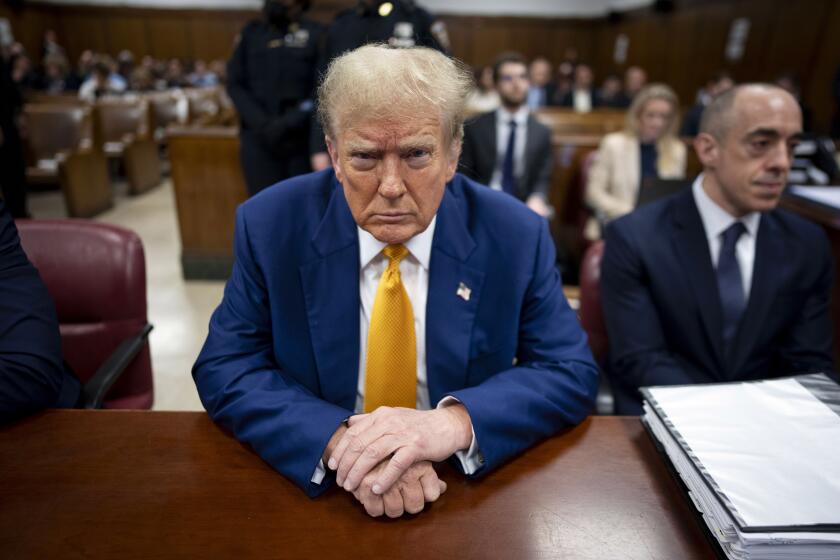What binds Bush, Kerry
In the last several months, Tim Russert of NBC’s “Meet the Press,” one of TV’s toughest interviewers, struck out with two of his biggest “gets”:
In August, he quizzed Sen. John F. Kerry, “You both were members of Skull and Bones, a secret society at Yale. What does that tell us?”
Kerry: “Not much, because it’s a secret.”
In February, he asked President Bush, “You were both in Skull and Bones, the secret society?”
Bush: “It’s so secret we can’t talk about it.”
Such coyness on the part of grown men! And yet, their recalcitrance does prove one thing: The guys can keep a secret.
But is that good? Secrecy, after all, leads to rumors. And the rumors about Skull and Bones -- naked confessions of sexual conquests, grave robbing, free money and, of course, plans for world domination -- don’t look good on the presidential resume. Those rumors received a boost when it became apparent that, for the first time in history, two Bonesmen will face off for the presidency in November.
“It’s certainly a coincidence that lends itself to attention,” said the historian Kevin Phillips, whose recent work, “American Dynasty,” explores how the Bushes have benefited from what he calls “crony capitalism.” “Is it nefarious? I guess it’s a little insidious.”
Journalist and author Ron Rosenbaum (Yale ‘68), who wrote the seminal article on Skull and Bones for Esquire in 1977, thinks the Bush-Kerry coincidence should be treated thoughtfully. “Obviously, it’s part of what shaped the character of the two presidential candidates, and yet there’s a lot of overblown conspiracy theory that has outweighed the seriousness.”
Indeed, a serious political discussion might examine the meaning of both presidential candidates maintaining an inherently undemocratic affiliation and refusing to address an important aspect of their university lives. Instead, discussions on the Internet, talk radio and cable TV, generally turn on suspicions that Skull and Bones has attempted to mastermind a “new world order” in which only a handful of wealthy, old-line families control the planet.
“Is this a satanic cult? No. Is this a group that operates as a shadow government? No. Is this a group that has an institutionalized superiority complex? Yes,” said Alexandra Robbins, a 27-year-old journalist and Yale alumna whose book “Secrets of the Tomb” explores the 172-year-old club based on interviews with 100 anonymous Bonesmen. Bones, she said, has “a power agenda” that “prioritizes its own elitism and its own members above other concerns.”
Rosenbaum disputes that there is a specific “power agenda” at work. “I would say the best way of describing it is by analogy to the old boys’ network in England, where graduates of Eton and Oxford and Cambridge form a network of influence and power and share a mind-set. They know each other, they trust each other and they bonded at an early age.”
If nothing else, Skull and Bones has produced some odd bedfellows. “I am a liberal Democratic criminal defense attorney who voted for George Bush, and I will vote for him again,” said Bush’s fellow Bonesman Donald Etra, an Orthodox Jew who lives in L.A. and was appointed by Bush to the U.S. Holocaust Memorial Council. Etra, who called himself “a strong Zionist,” said one of his closest Bones friends is a Jordanian-born Muslim. “Most of us,” he said, “put friendship first and politics a far, far second.”
Next month, an eclectic group of 15 juniors will be tapped for Skull and Bones by this year’s seniors. There have never been specific criteria for membership, which in generations past might have included some standard campus types: the editor of the Yale Daily, an outstanding athlete, a son of a Bonesman etc. Women were admitted in 1991, after a rancorous 20-year battle.
Bones members spend each Thursday and Sunday of their senior year in the Tomb, the group’s clubhouse on High Street in the middle of the Yale campus. It is windowless, ersatz Greco-Egyptian temple, readily identified on Yale maps.
“It’s kind of foreboding looking,” said a 48-year-old Toronto writer who sneaked into the Tomb with her boyfriend during spring break 1975. “They made it into this big mystery thing. But it wasn’t. It’s just like a big clubhouse, but it’s not in a tree.” There was a large dining room with a long table, and she recalled a room full of license plates. “They were always ripping things off with ‘322’ on them.”
The number 322 is a variation on the year (1832) that the club was founded by William H. Russell, a Yale student who modeled it after one he’d encountered in Germany. At its inception, said Dr. Alan Cross, one of Kerry’s classmates and a third-generation Bonesman, the club was “basically a debating society, where members of the senior class would get together and discuss important topics of the day.” (Bonesmen have a special regard for Demosthenes, the famed Greek orator who died in 322 BC.)
In later generations, the conversations became not just confessional but confrontational in the manner of group therapy, according to some reports. There was always security, said Cross, a professor of social medicine and pediatrics at the University of North Carolina, Chapel Hill, in the knowledge that “what goes on inside, what people reveal about themselves ... would stay inside the building.”
Not surprisingly, given Yale’s lofty status in the firmament of American universities, Bonesmen often have occupied positions of power and prestige as adults. Three have become president (both Bushes and William Howard Taft). A partial roster of the famous includes diplomat Averill Harriman, poet Archibald MacLeish, financier Dean Witter Jr., Time magazine founder Henry Luce, Supreme Court Justice Potter Stewart, national security advisor McGeorge Bundy, writers William F. Buckley and Christopher Buckley, former Sen. David Boren and FedEx founder Frederick Smith.
Not every Bonesman has loved the club unconditionally. As an adult, William Sloane Coffin, the Yale chaplain known for his opposition to the Vietnam War, developed a distaste for it. “He thought it was inappropriate,” said Cross. “A snobby thing. We were discouraged from gathering in groups around campus because it would perpetuate the notion that this was an elitist group.”
But of course, it is an elite group. Members can’t apply for membership -- they are secretly elected. They have lifelong access to Deer Island, a private 40-acre sanctuary in the St. Lawrence River, which is owned by Skull and Bones’ corporate parent, the Russell Trust Assn. And they are accorded other, less tangible benefits for life, not the least of which are their connections to the well-connected.
The Bush family has a long history with Skull and Bones. George W. Bush’s father tapped him in 1967, as a favor to the seniors who nominated him. The president’s grandfather, Prescott Bush, who was a U.S. senator, supposedly boasted in a journal that he stole the skull of Geronimo in 1918 for display among the many osseous relics in the Tomb, according to Robbins.
The current college generation of Bushes may represent a break in family tradition: Barbara Bush, a Yale senior, reportedly rejected an invitation to join the club.
Kerry, tapped in 1965, has no family history with Bones, although David Thorne, the twin of his first wife, Julia, is a member, as was his current wife’s first father-in-law, John Heinz.
Whether the president and his challenger are influenced by their Skull and Bones associations is, in a general sense, a matter of record. Both men have close friends and political contributors who are Bonesmen. Bush’s early forays into business were helped along by older Bonesmen. Bush has appointed several of his clubmates to government positions, including William H. Donaldson, the head of the Securities and Exchange Commission.
Tales from a ‘savage’
The general goings on in the Tomb -- particularly of eras past -- are not truly secret anymore. This is due, mostly, to the investigative efforts of the two Yalie journalists, Rosenbaum and Robbins.
Robbins was an editorial assistant in the Washington bureau of the New Yorker when she first wrote a story about Skull and Bones for the Atlantic in 2000, which she expanded into a book two years later. Her own membership in a Yale secret society, Scroll and Key, helped open doors. “I got a lot of hang-ups and a lot of gruff voices saying, ‘I’m not talking to you about that!’ ” But when she identified herself as a “savage” -- Bones-speak for a member of another secret society -- it worked as an entree. (Regular folks are “barbarians.”)
Robbins has revealed that all Bonesmen receive lifelong nicknames, some handed down. (The president’s father, she writes, was “Magog,” a name given to the most sexually experienced Bonesman. George W. never got around to choosing a nickname and was dubbed “Temporary.”)
Like Rosenbaum (who has participated in covert taping operations of Bones rituals with infrared equipment), Robbins has written about the Tomb’s initiation rites. Bonesmen dress up as a variety of characters -- “right out of Harry Potter meets Dracula” -- and conduct what she has described as “a cross between haunted-house antics and a human pinball game.”
“World domination aside,” she writes in “Secrets of the Tomb,” the most pervasive rumors about Bones are that initiates must masturbate in a coffin while recounting their sexual exploits and that their candor is ultimately rewarded with a no-strings gift of $15,000.”
No Bonesmen interviewed for this article would comment on the nature of the confessional conversations. But Cross and Etra laughed at the idea that there was a monetary gift. “There was no check,” said Cross. Another Bonesman who graduated from Yale in 1975 and lives in Los Angeles, agreed: “That’s ridiculous! I never got any money.”
‘Somewhat laughable’
Despite the fact that the presidential race has kindled interest in Skull and Bones, many believe the club has been in a long decline. Admitting women may have struck a blow for equality, but the Tomb just hasn’t generated much juicy buzz since then.
These days, wrote Franklin Foer in an April 2000 issue of the New Republic, Yale’s secret societies are “high temples of political correctness” where women outnumber men and “conservatives are scarce.”
While Kerry has said that he favored admitting women, the Bush position is not known. However, rumors have it that some older Bonesmen have forsaken the club now that it is coed.
“Once upon a time there was something called the Eastern Establishment, and Skull and Bones was a significant institution feeding into it,” said Jacob Weisberg, 39, editor of the online magazine Slate. “There is the residue of it, but it is not the same kind of network, not the same kind of career path.”
Weisberg should know.
In spring 1986, Weisberg, a Yale student interning at the New Republic, was invited to Kerry’s office. “I was writing about politics, so I thought maybe he was going to give me a scoop or something,” Weisberg said. But when Weisberg showed up, Kerry tapped him for Skull and Bones.
“I said, ‘Sen. Kerry, as a liberal, how do you justify supporting this club that doesn’t admit women?’ ”
Kerry was taken aback. According to Weisberg, Kerry said: “I’ve marched with battered women.”
Weisberg declined the tap and has no regrets.
“The institution is somewhat laughable at this point,” he said. “That we’re having a presidential race with two alumni of this club tells you something, but it tells you more about what’s changed, because it’s inconceivable that in 20 years we’ll have an election where two candidates are from Skull and Bones. This is the last time this could plausibly happen. I think it’s sort of the last gasp.”
More to Read
Get the L.A. Times Politics newsletter
Deeply reported insights into legislation, politics and policy from Sacramento, Washington and beyond. In your inbox three times per week.
You may occasionally receive promotional content from the Los Angeles Times.







